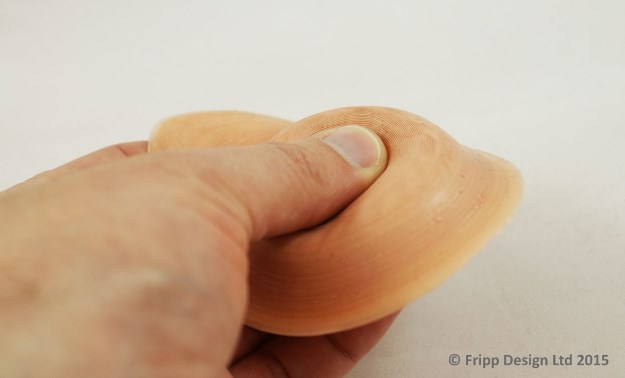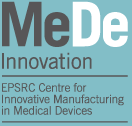Partner news: Fripp Design Ltd awarded UK Patent for 3D printing silicone

February 17, 2016
This is a momentous moment for everyone associated with Sheffield and London based Fripp Design and Research; their method for 3D Printing silicone has been granted a UK patent.
“This is a significant step forward for the company and its shareholders” stated Steve Roberts, Director and co owner of the company “It finally recognises the inventiveness of the method we have discovered which, on the face of it, would appear to be obvious yet nobody else had thought of it before us”.
The UK patent is specific to a method for creating 3 dimensional geometry from a class of polymers using the ‘addition curing’ method of vulcanisation. In this method, there are three active components; a base oil, a cross linker and a catalyst. The role of the cross linker is to determine the softness of the rubber to be created and the catalysts role is to accelerate the curing time. Historically you would mix these three components together, place in a mould, wait some time and the oil would turn into rubber within the mould.
What Fripp Design and Research figured out is how to use the catalyst to create 3 dimensional geometry without the need for a mould. “Tom Fripp and the team were playing around with platinum curing silicone in the office when they all had what I describe as the ‘light bulb moment’ stated Roberts “We realised that we could extrude the catalyst into a bath of silicone oil and catalyst to create 3 dimensional geometry. It was the combination of 11 years product design experience, being consumers of 3D Printing and learning the chemistry of addition curing silicone that gave us the knowledge and expertise to figure out the IP”.
A key differentiator of the Picsima method is the fact that it cures any commercially available platinum curing silicone “This is significant because we are not creating materials that would need to be tested and approved for use” added Roberts “If the material is approved for use in moulds, then the material is approved as a material for 3D printing as well”.
The company secured funding from both Innovate UK and Horizon 2020 which allowed them to build a test rig to demonstrate the feasibility to control the extrusion, creating 3D rubber parts from .STL CAD data. “Many industry experts have seen the system and have complimented the team on the simplicity of our discovery” continued Roberts “We now have to turn that simplicity into a commercial 3D Print offer under our Picsima brand”. The company have other IP in how to create parts with multiple softness within a single part, but the current focus is to develop Picsima to meet the growing demand of companies asking for single softness silicone parts. The company are currently seeking investment to continue the product development to meet the growing market need.
“With the UK patent granted, our focus now turns to Europe, North America and China as we see these as the three key markets for our portfolio of IP in Picsima” concluded Roberts.
If you wish to find out more about Picsima, there is dedicated website at www.picsima.com.
- July 2019
- February 2019
- December 2018
- November 2018
- October 2018
- August 2018
- July 2018
- June 2018
- May 2018
- April 2018
- March 2018
- February 2018
- January 2018
- December 2017
- November 2017
- October 2017
- September 2017
- August 2017
- June 2017
- May 2017
- March 2017
- February 2017
- January 2017
- November 2016
- October 2016
- September 2016
- July 2016
- June 2016
- May 2016
- April 2016
- March 2016
- February 2016
- January 2016
- December 2015
- November 2015
- September 2015
- July 2015
- June 2015
- May 2015
- April 2015
- March 2015
- February 2015
- January 2015
- December 2014
- November 2014
- October 2014
- September 2014
- August 2014
- July 2014
- June 2014
- April 2014
- March 2014
- February 2014
- January 2014
- December 2013
- October 2013
- September 2013
- February 2013
